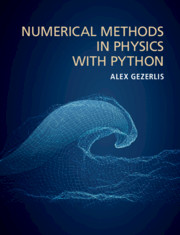Refine search
Actions for selected content:
2540 results in Computational Science
Appendix C - Math Background
-
- Book:
- Numerical Methods in Physics with Python
- Published online:
- 14 August 2020
- Print publication:
- 27 August 2020, pp 566-572
-
- Chapter
- Export citation
4 - Matrices
-
- Book:
- Numerical Methods in Physics with Python
- Published online:
- 14 August 2020
- Print publication:
- 27 August 2020, pp 121-242
-
- Chapter
- Export citation
Dedication
-
- Book:
- Numerical Methods in Physics with Python
- Published online:
- 14 August 2020
- Print publication:
- 27 August 2020, pp v-vi
-
- Chapter
- Export citation
Contents
-
- Book:
- Numerical Methods in Physics with Python
- Published online:
- 14 August 2020
- Print publication:
- 27 August 2020, pp vii-xii
-
- Chapter
- Export citation
2 - Numbers
-
- Book:
- Numerical Methods in Physics with Python
- Published online:
- 14 August 2020
- Print publication:
- 27 August 2020, pp 28-84
-
- Chapter
- Export citation
8 - Differential Equations
-
- Book:
- Numerical Methods in Physics with Python
- Published online:
- 14 August 2020
- Print publication:
- 27 August 2020, pp 494-558
-
- Chapter
- Export citation
7 - Integrals
-
- Book:
- Numerical Methods in Physics with Python
- Published online:
- 14 August 2020
- Print publication:
- 27 August 2020, pp 393-493
-
- Chapter
- Export citation
5 - Roots
-
- Book:
- Numerical Methods in Physics with Python
- Published online:
- 14 August 2020
- Print publication:
- 27 August 2020, pp 243-310
-
- Chapter
- Export citation
3 - Derivatives
-
- Book:
- Numerical Methods in Physics with Python
- Published online:
- 14 August 2020
- Print publication:
- 27 August 2020, pp 85-120
-
- Chapter
- Export citation
Appendix A - Installation and Setup
-
- Book:
- Numerical Methods in Physics with Python
- Published online:
- 14 August 2020
- Print publication:
- 27 August 2020, pp 559-559
-
- Chapter
- Export citation
Bibliography
-
- Book:
- Numerical Methods in Physics with Python
- Published online:
- 14 August 2020
- Print publication:
- 27 August 2020, pp 573-576
-
- Chapter
- Export citation
Appendix B - Number Representations
-
- Book:
- Numerical Methods in Physics with Python
- Published online:
- 14 August 2020
- Print publication:
- 27 August 2020, pp 560-565
-
- Chapter
- Export citation
Index
-
- Book:
- Numerical Methods in Physics with Python
- Published online:
- 14 August 2020
- Print publication:
- 27 August 2020, pp 577-586
-
- Chapter
- Export citation
1 - Idiomatic Python
-
- Book:
- Numerical Methods in Physics with Python
- Published online:
- 14 August 2020
- Print publication:
- 27 August 2020, pp 1-27
-
- Chapter
- Export citation
Frontmatter
-
- Book:
- Numerical Methods in Physics with Python
- Published online:
- 14 August 2020
- Print publication:
- 27 August 2020, pp i-iv
-
- Chapter
- Export citation
Preface
-
- Book:
- Numerical Methods in Physics with Python
- Published online:
- 14 August 2020
- Print publication:
- 27 August 2020, pp xiii-xvi
-
- Chapter
- Export citation
List of codes
-
- Book:
- Numerical Methods in Physics with Python
- Published online:
- 14 August 2020
- Print publication:
- 27 August 2020, pp xvii-xviii
-
- Chapter
- Export citation
6 - Approximation
-
- Book:
- Numerical Methods in Physics with Python
- Published online:
- 14 August 2020
- Print publication:
- 27 August 2020, pp 311-392
-
- Chapter
- Export citation

Numerical Methods in Physics with Python
-
- Published online:
- 14 August 2020
- Print publication:
- 27 August 2020
8 - When Models Meet Data
- from Part II - Central Machine Learning Problems
-
- Book:
- Mathematics for Machine Learning
- Published online:
- 20 February 2020
- Print publication:
- 23 April 2020, pp 225-259
-
- Chapter
- Export citation
